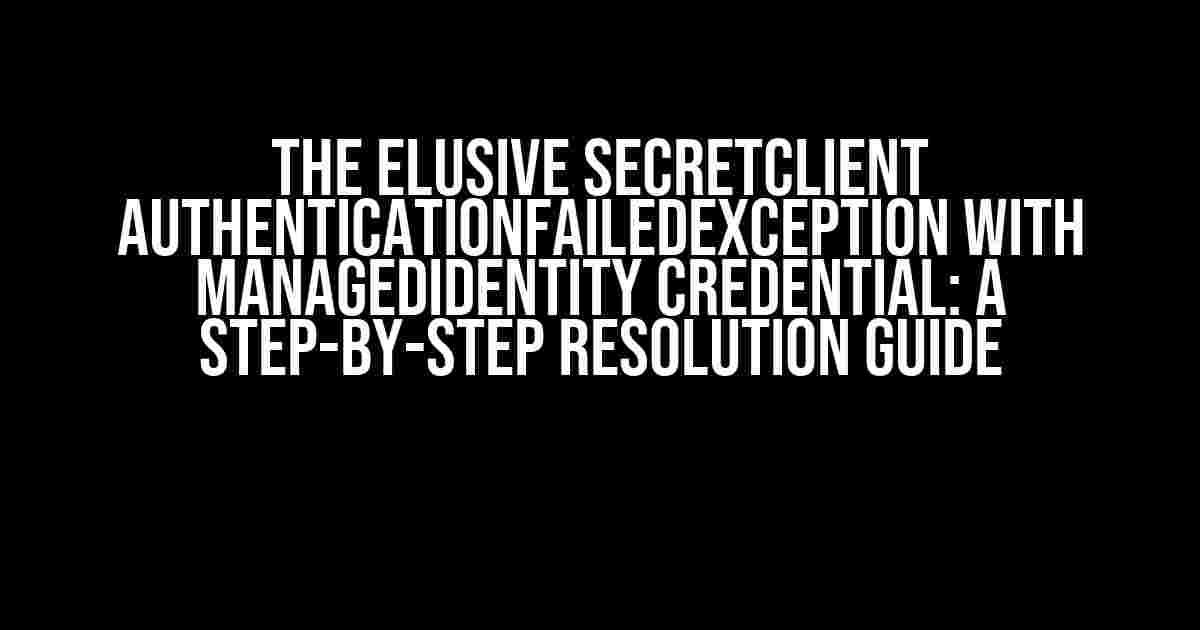Are you tired of encountering the infuriating SecretClient AuthenticationFailedException error when attempting to use the ManagedIdentity credential in your Azure-based applications? Fear not, dear developer, for you’ve stumbled upon the ultimate solution guide. In this comprehensive article, we’ll delve into the heart of the issue, explore the underlying causes, and provide a clear, step-by-step approach to resolving this pesky problem once and for all.
What is the SecretClient AuthenticationFailedException?
The SecretClient AuthenticationFailedException is a runtime error that occurs when the Azure SDK’s SecretClient fails to authenticate with Azure Key Vault using the ManagedIdentity credential. This exception is often accompanied by a cryptic error message, leaving developers scratching their heads and wondering what went wrong.
Causes of the AuthenticationFailedException
Before we dive into the solutions, it’s essential to understand the common causes of the AuthenticationFailedException:
- Incorrectly configured Azure Identity libraries: Mismatched or outdated library versions can lead to authentication issues.
- Insufficient permissions or access control: The ManagedIdentity credential might lack the necessary permissions to access Azure Key Vault.
- Invalid or expired credentials: Expired or invalid credentials can cause the SecretClient to fail authentication.
- Network connectivity issues: Firewalls, proxies, or network configuration problems can block the SecretClient from communicating with Azure Key Vault.
Step-by-Step Resolution Guide
Now, let’s tackle the AuthenticationFailedException head-on with a systematic approach:
Step 1: Verify Azure Identity Libraries
Ensure you’re using the correct and up-to-date Azure Identity libraries:
dotnet add package Azure.Identity
dotnet add package Azure.Security.KeyVault.Secrets
Verify the library versions by checking the csproj file or using the following command:
dotnet list package
Step 2: Configure ManagedIdentity Credential
Double-check that the ManagedIdentity credential is properly configured:
var credential = new DefaultAzureCredential();
var secretClient = new SecretClient(new Uri("https://.vault.azure.net/"), credential);
Make sure the Azure resource has the correct permissions and access control:
| Resource | Permission |
|---|---|
| Azure Key Vault | Get, List, and Set secrets |
| Managed Identity | Read and Write permissions on Azure Key Vault |
Step 3: Verify Credentials and Authentication
Check the credentials and authentication flow:
var tokenAcquisition = credential.GetToken(
new TokenRequestContext(scopes: new[] { "https://vault.azure.net/.default" })
);
var accessToken = tokenAcquisition.Token;
Validate the access token by checking its expiration date and claims:
Console.WriteLine($"AccessToken: {accessToken.Value}");
Console.WriteLine($"ExpiresOn: {accessToken.ExpiresOn}");
Console.WriteLine($"Claims: {accessToken.Claims}");
Step 4: Check Network Connectivity
Verify network connectivity and configuration:
ping .vault.azure.net
Ensure firewalls, proxies, or network configuration don’t block the SecretClient from communicating with Azure Key Vault.
Step 5: Implement Retry Logic
Implement retry logic to handle transient errors and timeouts:
var retryPolicy = new RetryPolicy(new ExponentialBackoff(settings: new ExponentialBackoffSettings
{
MaxDelay = TimeSpan.FromSeconds(30),
MinDelay = TimeSpan.FromSeconds(1),
MaxRetryCount = 3
}));
secretClient.SetRetryPolicy(retryPolicy);
Conclusion
By following this systematic approach, you should be able to resolve the SecretClient AuthenticationFailedException with ManagedIdentity credential. Remember to:
- Verify Azure Identity libraries and configurations.
- Configure the ManagedIdentity credential correctly.
- Verify credentials and authentication flow.
- Check network connectivity and configuration.
- Implement retry logic for transient errors and timeouts.
With these steps, you’ll be well on your way to a seamless authentication experience with Azure Key Vault and the SecretClient.
Additional Resources
For further reading and troubleshooting, we recommend exploring the following resources:
- Azure Managed Identities documentation
- Azure.Identity NuGet package documentation
- Azure Key Vault error codes and troubleshooting
We hope this comprehensive guide has helped you overcome the SecretClient AuthenticationFailedException with ManagedIdentity credential. Happy coding!
Frequently Asked Questions
Get the inside scoop on troubleshooting the SecretClient AuthenticationFailedException with ManagedIdentity credential!
What is the SecretClient AuthenticationFailedException?
The SecretClient AuthenticationFailedException is an error that occurs when the SecretClient, using the ManagedIdentity credential, fails to authenticate with the Azure Key Vault or Azure Active Directory. This exception is usually thrown when the managed identity is not properly configured or the permissions are not set correctly.
What are the common causes of the SecretClient AuthenticationFailedException?
The most common causes of the SecretClient AuthenticationFailedException include incorrect Azure Identity configuration, missing or invalid credentials, insufficient permissions, and network connectivity issues. It’s also possible that the managed identity is not enabled or registered correctly in Azure AD.
How do I troubleshoot the SecretClient AuthenticationFailedException?
To troubleshoot the SecretClient AuthenticationFailedException, start by checking the Azure Identity configuration and ensuring that the credentials are valid and up-to-date. Verify that the managed identity is enabled and registered correctly in Azure AD, and that the necessary permissions are granted. You can also try enabling debug logging to get more detailed error messages.
Can I use a different credential type to avoid the SecretClient AuthenticationFailedException?
Yes, you can use a different credential type, such as the DefaultAzureCredential or the ClientSecretCredential, depending on your specific use case and requirements. However, keep in mind that each credential type has its own configuration and setup requirements, so make sure to follow the correct steps for the chosen credential type.
Where can I find more information about the SecretClient and ManagedIdentity credential?
You can find more information about the SecretClient and ManagedIdentity credential in the official Microsoft Azure documentation, as well as in various online forums and communities, such as Stack Overflow and GitHub. Additionally, you can consult the Azure SDK and library documentation for your specific programming language.
